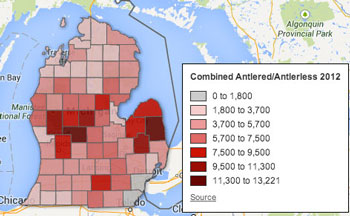Ann Arbor OKs $20K to Create Deer Plan
The Ann Arbor city council has voted to appropriate $20,000 from the general fund for development of a “community endorsed deer management plan” and to accept formally a deer management options report from city administrator Steve Powers. [.pdf of Aug. 14, 2014 deer management options report]

Combined antlered/antlerless deer taken in 2012. (Data from Michigan Department of Natural resources. Map by The Chronicle. Image links to dynamic map.)
Action came in a unanimous vote at the council’s Aug. 18, 2104 meeting, after about 15 minutes of discussion. The council had directed the preparation of the report in a resolution approved at its May 5, 2014 meeting. The report, which presented various options to the council, was to have been delivered by July 31.
Fall 2015 is the earliest date identified in the report as a possible timeframe for a culling of the herd.
Before developing a specific plan – that could involve killing deer or not – input from Washtenaw County Parks and Recreation and the University of Michigan would be sought. And the Michigan Department of Natural Resources would need to approve any plan for deer management. The Aug. 14 report includes descriptions of deer management plans in other Michigan cities that range from ordinances prohibiting the feeding of deer to culling programs that shut down city parks and prescribe shooting lanes for archers.
City of Ann Arbor staff estimate that six months would be needed for public engagement. That public engagement could start within 45 days of city council approval to proceed.
Estimated staff time to develop the specific plan is 160 hours, according to the Aug. 14 report. Contractual public engagement and support to develop a management plan are estimated at $20,000.
Other facts included in the plan are the fact that neither city parks nor golf courses have had vegetation damage by deer. The cost to the city for disposing of deer carcasses in fiscal year 2014 was $5,850.
Estimated cost to kill 40-50 deer in the city of Ann Arbor is $25,000-$27,000 per year. That amount includes city staff administration cost in the amount of $14,000.
A Michigan DNR report indicates that in 2012 there were about 6,600 deer taken by hunters in Washtenaw County.
All deer-car accidents in Washtenaw County from 2004 through 2013 are plotted in the dynamic map below. Map is by The Chronicle with data from michigantrafficcrashfacts.org
The city of Ann Arbor has two deer crossing signs, one at Huron Parkway and Hubbard and the other on Dhu Varren Road.

Since 2004, the number of vehicle-deer crashes in Washtenaw County has shown a slight downward trend. (Data from michigantrafficcrashfacts.org, chart by The Chronicle)

Since 2004, the number of vehicle-deer crashes in Ann Arbor has shown a slight upward trend. (Data from michigantrafficcrashfacts.org, chart by The Chronicle)
This brief was filed from the city council’s chambers on the second floor of city hall, located at 301 E. Huron.




The number of deer-auto accidents are up already this year– and the heavy time for deer-car collisions doesn’t come until around October!
Nobody wins in a collision. Even in no passengers are hurt, there is major cost and damage to vehicles.
“Other facts included in the plan are the fact that neither city parks nor golf courses have had vegetation damage by deer.”
That’s a surprise. Were they only talking about landscaped parks? I imagine that some of the natural areas, especially Marshall and Barton, maybe Dolph, Bird Hills, suffer from heavy impact by deer feeding. One of the reasons garlic mustard and buckthorn are invasive is that deer don’t eat them. High deer population + invasives are a double-whammy for our native wildflowers.
Re (2): I picked up on that too. I’m guessing that the translation is “Parks personnel haven’t particularly noticed a problem”.
I wonder whether the NAP staff were consulted.
I asked about this in a caucus question (answers available at a2gov.legistar.com). The response I received is that staff have seen species-specific damage but not a case where all vegetation at browsing level has been eaten.
A note on the staff responses to agenda items mentioned by Chuck Warpehoski. I’ve swapped the in the address of the .pdf document as the target to the hyperlink.
For readers’ future reference, the staff responses to councilmember questions about agenda items are attached to the Legistar agenda under “Communications from the City Administrator.” Attachment of that document to the online agenda typically takes place starting around 4 p.m. on the afternoon of the council’s meeting. It’s around the same time that the agenda begins to be populated with names of people signed up for public commentary reserved time. If you’re watching a council meeting live, familiarity with that document can be a useful aid in following some of the deliberations.
Re (4.) Thanks to CM Warpehoski for asking that question. It appears that the statement in the administrator’s report was incorrect. The lack of all vegetation observed to be eaten up to the browse line does not equate to “no damage”.